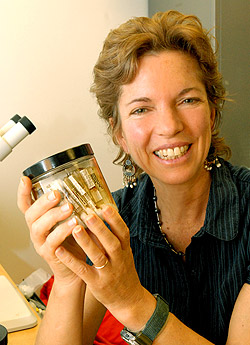Berkeleyan
 |
Atop Finkol, a summit on the island of Kosrae in Micronesia, Berkeley arachnologist Rosemary Gillespie, who researches colonization and adaptive speciation among spiders, peers in the direction indicated by her local guide while on a research trip in the region. |
Tracing a spidery family tree
Insect biologist Rosemary Gillespie's research has taken her from Scotland to Hawaii to Berkeley. Here, at least, she doesn't have to capture specimens with a tuning fork
![]()
| 26 September 2007
A visit to Rosemary Gillespie's office is not for the arachnophobic. Galloping across her door is a spider the size of an SUV, hunting fleeing humans. Its profusion of legs are hairy and spindly; its fangs glint like hard steel in the sun.
Though this movie monster is the stuff of nightmares, its smaller, offscreen brethren have been a dream come true for spider expert Gillespie.
A professor of environmental science, policy, and management, Gillespie's studies of spider evolution have carried her from the misty moors of Scotland to islands across the Pacific. Her analyses of island colonization, spider-style, have demonstrated that organisms invade virgin territory, blossom into new species, and establish communities in a predictable pattern.
Gillespie's interest in arachnids started early in life. Growing up in rural southwestern Scotland, she learned to respect her eight-legged neighbors. "We were forever rescuing spiders from going down the sink. If you wash them down, it's going to rain. And it's always raining, so you never want to make it rain more," she says. At night, before sleeping, she plucked spiders from their webs and moved them above her bed for good luck.
At the University of Edinburgh, she studied how spiders select their web sites (in the pre-digital sense of the phrase). She remembers holding a tuning fork to their webs to catch them. Mistaking the vibrations for the thrashing of prey, the arachnids would leap right onto her fork.
"I realized how fun and easy spiders were to work with," Gillespie says. "You could watch what they do, and they didn't fly away. They were telling me what they liked by building their webs."
By now an official arachnophile, Gillespie moved to the U.S. to study spider ecology at the University of Tennessee. To extend her arachnid research after graduation, she accepted a postdoctoral fellowship at the University of Hawaii at Manoa.
A lot of people might have rejoiced at the prospect of leaving Knoxville for tropical Oahu, but Gillespie wasn't one of them. "My vision of Hawaii was of just a huge tourist resort. There wasn't much appeal for me. I don't like the beach so much, to tell you the truth; it's just too hot."
But her work would take her far from Oahu's tourist hotels and the baking beaches. Her quarry, the Hawaiian happy-face spider, lives in the high-elevation rainforests around the islands' tall volcanoes. Gatorade-green with bold streaks and dots on its abdomen, many carry designs arranged into an Impressionist smiley face.
 Rosemary Gillespie (Peg Skorpinski photo) |
"I thought, this is odd, because these long-jawed spiders are always over water everywhere else, and this was in the middle of the forest," Gillespie recalls. "The more I looked, I realized that just about everything running around in this forest was a spiny-legged Tetragnathid."
Intrigued, Gillespie first tried to identify her catches. She turned for help to the first major scientific study of the islands' zoology - the Fauna Hawaiiensis, published in 1901. To use it, however, Gillespie first had to translate the descriptions of spiders from Latin into English. Though unwieldy and often vague, the text proved Gillespie had hit the biological version of pay dirt: Dozens of her spiders were new to science. Like Darwin's finches, her spiders were all descendants of a single ancestral species that evolved to fill many available niches.
But Gillespie's most exciting discovery was yet to come. Traveling down the Hawaiian archipelago to collect Tetragnathids, she kept experiencing spider déjà vu. She encountered what appeared to be the same set of species over and over: a large brown one that lived on bark, a small brown one that preferred twigs, a green leaf-dweller, and a maroon moss-lover.
Curious as to how each was related to the others, Gillespie compared their genetic material. In one way, the spiders showed a typical pattern of species evolution in Hawaii. The oldest came from Kauai, itself the oldest and northernmost island, with newer species progressing down the chain. In another way, their family tree turned out to be a big surprise.
Common sense would dictate that, say, the green leaf-dwellers on Kauai would be most closely related to those on Oahu. But here, appearances were deceiving. Spiders that looked the same weren't always kissing cousins. Nor did a spider's closest relatives always live on the same island. Instead, Gillespie found an intriguing story of colonization and adaptive speciation.
As each island rose from the waves and became suitable for habitation, these spiders "either hopped down the chain and stayed in their form or, when they landed on a new island, a maroon one would become a little brown one because there weren't little brown ones there already," Gillespie says. Here, isolation worked in the spiders' favor: With thousands of miles of ocean surrounding the islands, no other spiders were present to compete with. "It's almost like there's a race - who can fill the space first by dispersing or evolving into it?"
The fact that the islands have similar food webs eases their transitions; a similar handful of ecological niches exists on every island. The theory is borne out by Hawaii's web-spinning Tetragnathids as well as other spiders. Gillespie and her colleagues have established that while the same four web types are found on each island, those spiders spinning similar webs aren't closely related; each species evolved its web architecture independently.
The distribution of species provided Gillespie with even more clues about how ecological communities assemble. Kauai and Oahu, the oldest islands, had the largest percentage of unique species, but fewer species overall. Middle-aged Maui had the largest total number of native species. Young Hawaii had the fewest number of endemic spiders; too little time had passed for more to evolve.
"What seems to be happening is you get things piling into communities and you get more species than you expect given the environment," Gillespie says. As time passes, some of these go extinct and the species number aligns more closely with the ecology.
Gillespie is now finding the same story replayed across the Pacific. In the Society Islands, the Marquesas, Micronesia, and elsewhere, Gillespie has found repeating sets of spiders with family trees as complex as Hawaii's Tetragnathids.
Gillespie's studies of past colonization could help predict how island ecosystems will respond to today's tidal wave of new species. The growing popularity of jet travel and overseas shipping have besieged islands from Madagascar to Guam with an unprecedented number of new species. And when it comes to repelling newcomers, Gillespie is finding that not all islands are equal. An island's degree of isolation plays a strong part.
Islands that are isolated, Gillespie has found, should be more resilient to invasions over the short term. Some islands are isolated by their remote geographic location. Others are environmentally isolated; their altitude allows them to make their own weather. Both types of islands tend to have relatively few species with robust populations. However, success has lulled these creatures into producing fewer offspring - and that's a recipe for disaster in an age of invasion. "Island species have arisen in the context of limited species dispersal," Gillespie has written. "During prolonged habitat modification, they are likely to be swamped by non-natives."
Closer to home
Just back from a year's sabbatical in Montpellier, France, Gillespie is now focused on more local matters. As director of the Essig Museum of Entomology she is overseeing the transfer of more than 4.5 million pinned and labeled specimens from their historic home in Wellman Hall to the Valley Life Sciences Building. The move will bring all of the Berkeley Natural History Museums under one roof this fall, promoting the study of plant-insect interactions and other community ecology research.
Gillespie is also the director of another Berkeley Natural History Museums program called Exploring California Biodiversity. Each fall, graduate students funded by the National Science Foundation are paired with a class from local schools. Each class also gets to visit one of Berkeley's field stations in Big Sur, Northern California, or the Sierra Nevada.
"Right now, there's a tremendous disconnect between the exciting research that's going on in academia and what the general public hears about," Gillespie says. "This program is a way of fostering a culture of communicating science among our students." In turn, local schoolchildren get a first-hand glimpse of the ecology right outside their windows. Someday, a few of them might even be inspired to canopy their own beds with the webs of California spiders.

